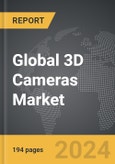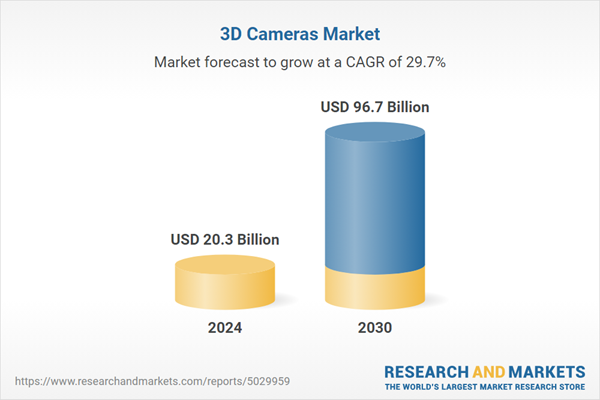The global market for 3D Cameras was valued at US$20.3 Billion in 2024 and is projected to reach US$96.7 Billion by 2030, growing at a CAGR of 29.7% from 2024 to 2030. This comprehensive report provides an in-depth analysis of market trends, drivers, and forecasts, helping you make informed business decisions. The report includes the most recent global tariff developments and how they impact the 3D Cameras market.
Segments: Technology (Stereo Vision, Time-of-Flight, Structured Light); End-Use (Professional Cameras, Smartphones, Tablets, Computers, Other End-Uses).
Geographic Regions/Countries: World; United States; Canada; Japan; China; Europe (France; Germany; Italy; United Kingdom; and Rest of Europe); Asia-Pacific; Rest of World.
The analysts continuously track trade developments worldwide, drawing insights from leading global economists and over 200 industry and policy institutions, including think tanks, trade organizations, and national economic advisory bodies. This intelligence is integrated into forecasting models to provide timely, data-driven analysis of emerging risks and opportunities.
Global 3D Cameras Market - Key Trends and Drivers Summarized
Why Are 3D Cameras Transforming the Imaging Landscape?
3D cameras have significantly transformed the imaging landscape by providing the capability to capture three-dimensional images and videos, offering a more immersive and realistic viewing experience. These cameras use stereoscopic imaging technology to mimic the way human eyes perceive depth, creating detailed and lifelike representations of objects and environments. Initially popularized in entertainment and media, 3D cameras have expanded their reach into various fields, including healthcare, automotive, and industrial automation. In healthcare, for instance, 3D imaging enables more accurate diagnostics and surgical planning by providing detailed views of anatomical structures. The automotive industry leverages 3D cameras for advanced driver assistance systems (ADAS) and autonomous vehicles, where precise depth perception is crucial for navigation and safety. The versatility and enhanced capabilities of 3D cameras have made them an essential tool in numerous applications, driving innovation and improving outcomes across different sectors.How Are Technological Advancements Enhancing 3D Camera Capabilities?
Technological advancements have played a critical role in enhancing the capabilities of 3D cameras, making them more efficient, affordable, and accessible. Developments in sensor technology, such as the use of time-of-flight (ToF) and structured light sensors, have improved the accuracy and resolution of 3D imaging. These sensors can capture fine details and measure depth with high precision, which is essential for applications like facial recognition, gesture control, and augmented reality (AR). Additionally, the integration of artificial intelligence (AI) and machine learning algorithms has enabled more sophisticated image processing and real-time analysis, enhancing the functionality of 3D cameras. AI-driven features like object detection and scene understanding have broadened the scope of 3D cameras, allowing for more advanced and interactive applications. The ongoing innovations in software and hardware are continuously pushing the boundaries of what 3D cameras can achieve, paving the way for new possibilities and applications.Why Are Various Industries Adopting 3D Cameras at an Increasing Rate?
The adoption of 3D cameras across various industries is accelerating due to their ability to provide detailed, accurate, and actionable visual information. In the e-commerce and retail sectors, 3D cameras are used to create virtual try-on solutions and interactive product displays, enhancing the shopping experience and reducing return rates. The architecture and construction industries utilize 3D cameras for site surveys, building information modeling (BIM), and progress monitoring, improving project accuracy and efficiency. In the field of security and surveillance, 3D cameras offer superior monitoring capabilities by providing depth information that helps distinguish between objects and identify potential threats. The gaming and entertainment industries continue to benefit from 3D cameras, which enable the creation of immersive environments and realistic character animations. The versatility of 3D cameras in capturing and analyzing complex visual data makes them invaluable across a wide range of applications, driving their widespread adoption.What Factors Are Driving the Growth in the 3D Camera Market?
The growth in the 3D camera market is driven by several factors, including technological advancements, expanding applications, and changing consumer preferences. Technological advancements in sensor accuracy, AI integration, and real-time processing have significantly enhanced the performance and utility of 3D cameras, making them more attractive to various industries. The expanding applications of 3D cameras in fields such as healthcare, automotive, e-commerce, and security are also propelling market growth, as these sectors leverage the technology for improved outcomes and operational efficiencies. Changing consumer preferences towards high-quality, immersive visual experiences are driving demand for 3D cameras in consumer electronics, such as smartphones and gaming devices. Additionally, the rise of AR and virtual reality (VR) technologies, which rely heavily on 3D imaging, is further fueling the demand for 3D cameras. The increasing investment in research and development for advanced 3D camera technologies, coupled with the growing need for precise and interactive visual solutions, is creating a robust growth trajectory for the 3D camera market.Report Scope
The report analyzes the 3D Cameras market, presented in terms of units. The analysis covers the key segments and geographic regions outlined below.Segments: Technology (Stereo Vision, Time-of-Flight, Structured Light); End-Use (Professional Cameras, Smartphones, Tablets, Computers, Other End-Uses).
Geographic Regions/Countries: World; United States; Canada; Japan; China; Europe (France; Germany; Italy; United Kingdom; and Rest of Europe); Asia-Pacific; Rest of World.
Key Insights:
- Market Growth: Understand the significant growth trajectory of the Stereo Vision Technology segment, which is expected to reach US$56.2 Billion by 2030 with a CAGR of a 30.3%. The Time-of-Flight Technology segment is also set to grow at 29.5% CAGR over the analysis period.
- Regional Analysis: Gain insights into the U.S. market, valued at $5.6 Billion in 2024, and China, forecasted to grow at an impressive 28.1% CAGR to reach $14.3 Billion by 2030. Discover growth trends in other key regions, including Japan, Canada, Germany, and the Asia-Pacific.
Why You Should Buy This Report:
- Detailed Market Analysis: Access a thorough analysis of the Global 3D Cameras Market, covering all major geographic regions and market segments.
- Competitive Insights: Get an overview of the competitive landscape, including the market presence of major players across different geographies.
- Future Trends and Drivers: Understand the key trends and drivers shaping the future of the Global 3D Cameras Market.
- Actionable Insights: Benefit from actionable insights that can help you identify new revenue opportunities and make strategic business decisions.
Key Questions Answered:
- How is the Global 3D Cameras Market expected to evolve by 2030?
- What are the main drivers and restraints affecting the market?
- Which market segments will grow the most over the forecast period?
- How will market shares for different regions and segments change by 2030?
- Who are the leading players in the market, and what are their prospects?
Report Features:
- Comprehensive Market Data: Independent analysis of annual sales and market forecasts in US$ Million from 2024 to 2030.
- In-Depth Regional Analysis: Detailed insights into key markets, including the U.S., China, Japan, Canada, Europe, Asia-Pacific, Latin America, Middle East, and Africa.
- Company Profiles: Coverage of players such as Canon, Inc., FARO Technologies, Inc., Fujifilm Holdings Corporation, GoPro, Inc., Intel Corporation and more.
- Complimentary Updates: Receive free report updates for one year to keep you informed of the latest market developments.
Some of the 42 companies featured in this 3D Cameras market report include:
- Canon, Inc.
- FARO Technologies, Inc.
- Fujifilm Holdings Corporation
- GoPro, Inc.
- Intel Corporation
- LG Electronics, Inc.
- Nikon Corporation
- Panasonic Corporation
- Samsung Electronics Co., Ltd.
- Sony Corporation
Tariff Impact Analysis: Key Insights for 2025
Global tariff negotiations across 180+ countries are reshaping supply chains, costs, and competitiveness. This report reflects the latest developments as of April 2025 and incorporates forward-looking insights into the market outlook.The analysts continuously track trade developments worldwide, drawing insights from leading global economists and over 200 industry and policy institutions, including think tanks, trade organizations, and national economic advisory bodies. This intelligence is integrated into forecasting models to provide timely, data-driven analysis of emerging risks and opportunities.
What’s Included in This Edition:
- Tariff-adjusted market forecasts by region and segment
- Analysis of cost and supply chain implications by sourcing and trade exposure
- Strategic insights into geographic shifts
Buyers receive a free July 2025 update with:
- Finalized tariff impacts and new trade agreement effects
- Updated projections reflecting global sourcing and cost shifts
- Expanded country-specific coverage across the industry
Table of Contents
I. METHODOLOGYII. EXECUTIVE SUMMARY2. FOCUS ON SELECT PLAYERSIII. MARKET ANALYSISIV. COMPETITION
1. MARKET OVERVIEW
3. MARKET TRENDS & DRIVERS
4. GLOBAL MARKET PERSPECTIVE
UNITED STATES
CANADA
JAPAN
CHINA
EUROPE
FRANCE
GERMANY
ITALY
UNITED KINGDOM
REST OF EUROPE
ASIA-PACIFIC
REST OF WORLD
Companies Mentioned (Partial List)
A selection of companies mentioned in this report includes, but is not limited to:
- Canon, Inc.
- FARO Technologies, Inc.
- Fujifilm Holdings Corporation
- GoPro, Inc.
- Intel Corporation
- LG Electronics, Inc.
- Nikon Corporation
- Panasonic Corporation
- Samsung Electronics Co., Ltd.
- Sony Corporation
Table Information
| Report Attribute | Details |
|---|---|
| No. of Pages | 194 |
| Published | April 2025 |
| Forecast Period | 2024 - 2030 |
| Estimated Market Value ( USD | $ 20.3 Billion |
| Forecasted Market Value ( USD | $ 96.7 Billion |
| Compound Annual Growth Rate | 29.7% |
| Regions Covered | Global |









